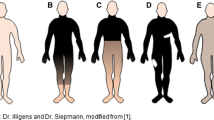Abstract
We studied sudomotor function in 21 patients with multiple system atrophy and in 11 age-matched controls. The extent and severity of the sudomotor deficit was assessed using the quantitative thermoregulatory sweat test. Central sudomotor function was studied by measuring sweating in response to raising body heat and administering thyrotropin-releasing hormone. Postganglionic sudomotor function was studied using the sudomotor axon reflex test evoked by nicotine. We conclude that in multiple system atrophy, thermoregulatory sudomotor dysfunction was more severe in the lower extremities. Heat stimulation increased the frequency of sweat expulsion and sweat rate on the forearm in moderate multiple system atrophy to a similar degree as controls but failed to do so on the thigh. Thyrotropin-releasing hormone enhanced sweating in moderate multiple system atrophy and controls. Results of the sudomotor axon reflex test indicate that in multiple system atrophy there is postganglionic sudomotor dysfunction which may be due to transsynaptic changes. These results suggest that the main lesion responsible for sudomotor dysfunction in multiple system atrophy is within the intermediolateral column cells of the spinal cord.
Similar content being viewed by others
References
Bannister R, Ardill L, Fentem P. Defective autonomic control of blood vessels in idiopathic orthostatic hypotension.Brain 1967;90: 725–746.
Cohen J, Low P, Fealey R, Sheps S, Jiang N-S. Somatic and autonomic function in progressive autonomic failure and multiple system atrophy.Ann Neurol 1987;22: 692–699.
Takahashi A, Takagi S, Yamamoto K, Yamada T, Ando K. Shy-Drager syndrome. Its correlation with olivo-ponto-cerebellar atrophy.Clin Neurol (Tokyo) 1969;9: 121–129.
Sobue I, Takayanagi T, Nakanishi T. Controlled trial of thyrotropin releasing hormone tartrate in ataxia of spinocerebellar degeneration.J Neurol Sci 1983;61: 235–248.
Mitsumoto H, Salgado ED, Negroski D, Hanson MR, Salanga VD, Wilber JF, Wilbourn AJ, Breuer AC, Leatherman J. Amyotrophic lateral sclerosis: Effects of acute intravenous and chronic subcutaneous administration of thyrotropin-releasing hormone in controlled trials.Neurology 1986;36: 152–159.
Kihara M, Watanabe H, Tomita T, Sugenoya J. A case of Shy-Drager syndrome, effectively treated with TRH, with special reference to local sweat rate.Neurol Med (Tokyo) 1986;25: 289–291.
Sandroni P, Ahlskog JE, Fealey RD, Low PA. Autonomic involvement in extrapyramidal and cerebellar system disorders.Clin Auton Res 1991;1: 147–155.
Sugenoya J, Kihara M, Ogawa T, Takahashi A, Mitsuma M, Yamashita Y. Effects of thyrotropin releasing hormone on human sudomotor and cutaneous vasomotor activity.Eur J Appl Physiol 1988;57: 632–638.
Ogawa T, Bullard RW. Characterization of subthreshold sudomotor neural impulse.J Appl Physiol 1972;33: 300–305.
Sugenoya J, Ogawa T. Characteristics of central sudomotor mechanism estimated by frequency of sweat expulsion.Jpn J Physiol 1985;35: 784–794.
Bini G, Hagbarth KE, Hynninem P, Wallin BG. Thermoregulatory and rhythm generating mechanisms governing the sudomotor and vasomotor outflow in human cutaneous nerves.J Physiol 1980;306: 537–552.
Weiner JS. The regional distribution of sweating.J Physiol 1945;104: 32–40.
Metcalf G. TRH: a possible mediator of thermoregulation.Nature 1974;252: 310–311.
Carino MA, Smith JR, Weick BG, Horita A. Effects of thyrotropinreleasing hormone (TRH) microinjected into various brain areas of conscious and pentrobarbital-pretreated rabbits.Life Sci 1976;19: 1687–1692.
Boschi G, Nomoto T, Rips R. Thyrotropin releasing hormone-induced hyperthermia in mice: possible involvement of adrenal and pituitary gland.Br J Pharmacol 1983;80: 229–233.
Brown MR. Thyrotropin releasing factor: a putative CNS regulator of the autonomic nervous system.Life Sci 1981;28: 1789–1795.
Tsunoda S, Shiozawa Z, Mano T. Microneurographic analysis of thyrotropin-releasing hormone effects on sympathetic outflow in human muscle nerve.J Auton Nerv Syst 1988;23: 207–211.
Johnson RH, Lee G de J, Oppenheime DR, Spalding JMK. Autonomic failure with orthostatic hypotension due to intermediolateral column degeneration. A report of two cases with autopsies.Q J Med 1966;35: 276–292.
Author information
Authors and Affiliations
Rights and permissions
About this article
Cite this article
Kihara, M., Sugenoya, J. & Takahashi, A. The assessment of sudomotor dysfunction in multiple system atrophy. Clinical Autonomic Research 1, 297–302 (1991). https://doi.org/10.1007/BF01819835
Received:
Accepted:
Issue Date:
DOI: https://doi.org/10.1007/BF01819835




